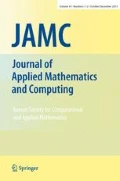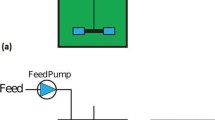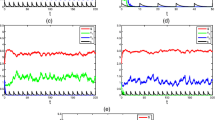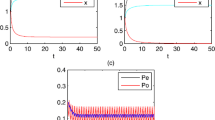Abstract
In this paper, we aim to investigate the dynamics and existence of periodic solutions of a state-dependent impulsive model for continuous flow bioreactors. In this model, the Monod’s growth rate is employed and an impulsive control strategy is used to control the quantity of microorganisms. Our study shows all solutions of the model are bounded; and the order-1 periodic solution exists under certain conditions. At the end of this paper, numerical simulations have been carried out to demonstrate our theoretical results and the performance of the bioreactor.










Similar content being viewed by others
References
Monod, J.: La technique de culture continue: Thorie et applications. Ann. l’Inst. Pasteur 79(4), 390–410 (1950)
Smith, H., Waltman, P.: The Theory of the Chemostat. Cambridge University Press, Cambridge (1994)
Nelson, M., Balakrishnan, E., Sidhu, H.: A fundamental analysis of continuous flow bioreactor and membrane reactor models with tessier kinetics. Chem. Eng. Commun. 199(3), 417–433 (2012)
Schulze, K., Lipe, R.: Relationship between substrate concentration, growth rate, and respiration rate of Escherichia coli in continuous culture. Arch. Microbiol. 48(1), 1–20 (1964)
Sonmezisik, M., Tanyolac, D., Seker, S., Tanyolac, A.: The double-substrate growth kinetics of sulfolobus solfataricus, a thermophilic sulfur-removing archeabacterium. Biochem. Eng. J. 1(3), 243–248 (1998)
Zhang, T.: Global analysis of continuous flow bioreactor and membrane reactor models with death and maintenance. J. Math. Chem. 50(8), 2239–2247 (2012)
Nelson, M., Kerr, T., Chen, X.: A fundamental analysis of continuous flow bioreactor and membrane reactor models with death and maintenance included. J. Chem. Eng. 3(1), 70–80 (2008)
Wolkowicz, G., Lu, Z.: Global dynamics of a mathematical model of competition in the chemostat: general response functions and differential death rates. SIAM J. Appl. Math. 52(1), 1–12 (1992)
Pirt, S.: The maintenance energy of bacteria in growing cultures. Proc. R. Soc. Lond. Ser-B 163, 224–231 (1965)
Liu, X.: Stability results for impulsive diffrential systems with applications to population growth models. Dyn. Stabil. Syst. 9(2), 163–174 (1994)
Liu, X., Chen, L.: Complex dynamics of holling type II Lotka-Volterra predatorprey system with impulsive perturbations on the predator. Chaos Solitons Fract. 16(2), 311–320 (2003)
Angelova, J., Dishliev, A.: Optimization problems for one-impulsive models from population dynamics. Nonlinear Anal. TMA 39(4), 483–497 (2000)
Liu, X., Chen, L.: Global dynamics of the periodic logistic system with periodic impulsive perturbations. J. Math. Anal. Appl. 289(1), 279–291 (2004)
Tang, S., Chen, L.: Impulsive semi-dynamical systems with applications in biological management (the doctor degree’s article). Chinese Academy of Science (2003)
Wang, T., Chen, L.: Global analysis of a three-dimensional delayed Michaelic-Menten chemostat-type models with pulsed input. J. Appl. Math. Comput. 35(1–2), 211–227 (2011)
Guo, H., Chen, L.: Qualitative analysis of a variable yield turbidostat model with impulsive state feedback control. J. Appl. Math. Comput. 33(1–2), 193–208 (2010)
Zhang, T., Meng, X., Song, Y., Zhang, T.: A stage-structured predator-prey SI model with disease in the prey and impulsive effects. Math. Model. Anal. 18(4), 505–528 (2013)
Zhang, T., Meng, X., Liu, R., Zhang, T.: Periodic solution of a pest management Gompertz model with impulsive state feedback control. Nonlinear Dyn. 78(2), 921–938 (2014)
Chen, L.: Pest control and geometric theory of semi-continuous dynamical system. J. Beihua Univ. 12, 1–9 (2011)
Zeng, G., Chen, L., Sun, L.: Existence of periodic solution of order one of planar impulsive autonomous system. J. Comput. Appl. Math. 186(2), 466–481 (2006)
Nelson, M.I., Balakrishnan, E., Sidhu, H., Chen, X.: A fundamental analysis of continuous flow bioreactor models and membrane reactor models to process industrial wastewaters. Chem. Eng. J. 140, 521–528 (2008)
Author information
Authors and Affiliations
Corresponding author
Rights and permissions
About this article
Cite this article
Chen, Z., Zhang, T., Tadé, M.O. et al. Existence of periodic solutions of a continuous flow bioreactor model with impulsive control in microorganisms. J. Appl. Math. Comput. 53, 471–486 (2017). https://doi.org/10.1007/s12190-015-0977-4
Received:
Published:
Issue Date:
DOI: https://doi.org/10.1007/s12190-015-0977-4




